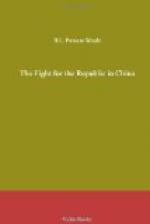Such was the man who was called upon to preside over the new government and parliament which was now assembling in Peking; and certainly it may be counted as an evidence of China’s traditional luck which brought him to the helm. General Li Yuan-hung knew well that the cool and singular plan which had been pursued to forge a national mandate for a revival of of the empire would take years completely to obliterate, and that the octopus-hold of the Military Party—the army being the one effective organization which had survived the Revolution—could not be loosened in a day,—in fact would have to be tolerated until the nation asserted itself and showed that it could and would be master. In the circumstances his authority could not but be very limited, disclosing itself in passive rather than in active ways. Wishing to be above all a constitutional President, he quickly saw that an interregnum must be philosophically accepted during which the Permanent Constitution would be worked out and the various parties forced to a general agreement; and thanks to this decision the year which has now elapsed since Yuan Shih-kai’s death has been almost entirely eventless, with the exception of the crisis which arose over the war-issue, a matter which is fully discussed elsewhere.
Meanwhile, in the closing months of 1916, the position was not a little singular. Two great political parties had arisen through the Revolution—the Kuo Ming Tang or Nationalists, who included all the Radical elements, and the Chinputang or Progressives, whose adherents were mainly men of the older official classes, and therefore conservative. The Yunnan movement, which had led to the overthrow of Yuan Shih-kai, had been inspired and very largely directed by the scholar Liang Ch’i-chao, a leader of the Chinputang. To this party, then, though numerically inferior to the Kuo Ming Tang, was due the honour and credit of re-establishing the Republic, the Kuo Ming Tang being under a cloud owing to the failure of the Second Revolution of 1913 which it had engineered. Nevertheless, owing to the Kuo Ming Tang being more genuinely republican,




